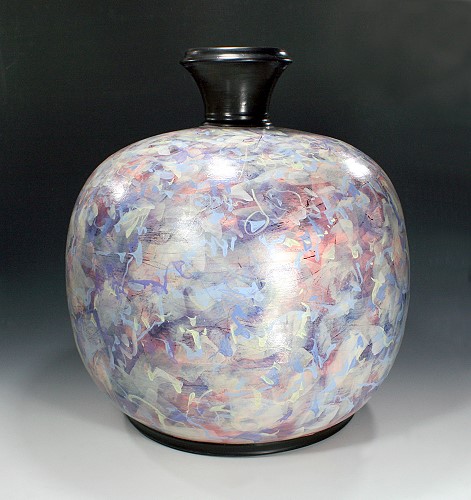
| Vasefinder International 2014 |
| Exhibitor 107 |
 |
|
Regis C. Brodie Wilton, New York, USA Title: Mauve Vase Year of Creation: 2011 Glaze: Matte white with a polychromed painted finish after firing Clay Body: Stoneware Dimensions: Height 26 inches Artist's Statement: I strongly believe in the power of a positive attitude and the ability to be flexible enough to respond to the creative opportunities that present themselves along the way, even when they're headed in an opposite direction. My work is exploratory in nature and it doesn't always go in a straight line. The true challenge is to see the many possibilities in the materials, the forming processes and the myriad effects that the firing and finishing can contribute to the energy and vitality of the piece. In an American Architecture course that I had taken early in my M.F.A. Program, I discovered a great architect who had a profound influence on me and on the direction my work was to take. His name was Louis Sullivan, a major Chicago Architect whose work dominated the architecture of the last two decades of the 19th century and the first two decades of the 20th century. He made American architecture, American. His architecture was honestly conceived, and the result showed the direct process by which it was constructed. Ornamentation of the architecture was indigenous to the structure. These structures were neither overly ornate nor pretentious. The ornament was an integral part of the total concept. Louis Sullivan developed new concepts in architecture, both in structural design and ornamentation, and he was a prophet of his time. It became very obvious to me that this person was someone I wanted to emulate. Here was someone who combined innovation in structure and innovation in surface ornamentation in buildings that were truly magnificent. Here was a system and philosophy that would enable me to combine my painting and sculpture skills with and on the ceramics vessel. It was in 1968 that I totally committed myself to this difficult task of combining a strong drawing and painting component onto, and becoming a part of, my vessel forms. In the early 80's I became aware of another kindred spirit who also combined surface and structure in a masterfully way and his name was Antoni Gaudi (1852-1926). I have been in Barcelona on two separate visits to study his art and his architecture first hand. He, like Sullivan, was also a pioneer and prophet of his time. My vessel or sculptural forms are elegant and classical. The surface painting, drawing, and textural surface treatment on the other hand, is out of the Abstract Expressionist and Post Modernist Schools. I love the interplay that is created between the refinements of the form and the spontaneously decorated surface. It contrasts the elegant with the organic. Like Sullivan, I do not establish a hierarchy or dominance of the form (mass) verses the surface (decoration). For, as I consider the form, the surface reveals itself as it becomes intrinsic and essential to the whole. The materials and the process of construction inspire and direct this unified sentiment and reveals its oneness of spirit. I am tight and at the same time loose. I prefer to work on a series of similar pieces. This gives me the opportunity to explore minor variations in contour and surface treatment. This focus allows me to achieve a heightened level of intuitiveness and aesthetic sensibility. The commitment to my work is sustained and regular and this too allows me to maintain an elevated level of awareness and clarity. Making art that has any value either for the viewer or the maker requires and demands this total commitment of energy and imagination. Over the years, I have worked with a verity of clays, forming techniques and firing processes. I do this to establish, expand, broaden and personalize my visual vocabulary. In addition to my ceramic work I enjoy painting. The painting process adds another dimension to this rich and diverse journey, which has and continues to challenge and stimulate my sense of creative expression. I try not to limit the scope or direction of my imagination. The difficult part of making art, or for that matter, seeking the best outcome in any activity, is being able to recognize potential--the obscure as well as the obvious. Is it mold or penicillin? Seeing the potential is the genius.
|
| To review detail photograph, click here. |
|
| Vasefinder Home |